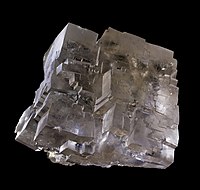
Photo from wikipedia
Abstract Non-polyamide composite nanofiltration (NF) membranes based on N-methyl- d -glucamine (NMG)-assisted polydopamine (PDA) coating were prepared by a simple deposition process followed by glutaraldehyde crosslinking, which showed excellent structural… Click to show full abstract
Abstract Non-polyamide composite nanofiltration (NF) membranes based on N-methyl- d -glucamine (NMG)-assisted polydopamine (PDA) coating were prepared by a simple deposition process followed by glutaraldehyde crosslinking, which showed excellent structural stability so as to solve the problem as encountered by commercial NF membrane. The addition of NMG promoted the deposition and polymerization of dopamine to form a dense and homogeneous selective layer with improved hydrophilicity in a time-saving mode. The composite membranes under optimal conditions exhibited high pure water flux of 10.29 L m− 2 h− 1 bar− 1, high organic dye rejection of over 99.0% and high Na2SO4 rejection of 81.2%. Particularly, as compared with the previously reported commercial NF membranes, one big advantage for high NaCl permeation was presented, due to low NaCl rejection with narrow range under the filtering process of different salt concentrations. Furthermore, 24 h continuous filtration experiment using mixtures of acid red 18 and NaCl showed low salt rejection ( 99.0%), indicating that the composite membranes have potential for dye/salt fractionation. Apart from providing a new candidate membrane for dye/salt fractionation, the successful development of structure-stable polydopamine-based NF membrane is expect to speed up the paces toward practical applications of non-polyamide membranes in the near future.
Journal Title: Desalination
Year Published: 2017
Link to full text (if available)
Share on Social Media: Sign Up to like & get
recommendations!